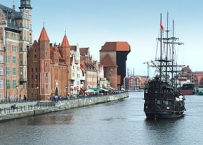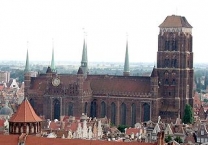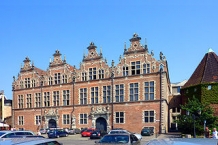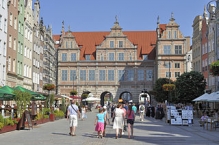Cycle Route EuroVelo: Baltic-Adriatic Route - leg Poland
No. of cycle route EV9
Actions
![]()
Please wait - map data are loading
Added on 16 Dec 2012,
last edited by biroto-Redaktion on 18 Sep 2023
Actions
Cycle route metrics
Total distance in km
860
Information about rights to the gps-track data | |
|---|---|
Rights owner | OpenStreetMap and Contributors + biroto-Redaktion (biroto.eu) |
Rights characteristic / license | Contains information from OpenStreetMap, which is made available here under the Open Database License(ODbL) |
Link to the description of the license | |
GPX file taken from | |
GPX file uploaded | by biroto-Redaktion on 18 Sep 2023
|
Track points in total
10.648
Track points per km (avg)
12
Start/endpoint
Start location
Gdańsk, PL (3 m NHN)
End location
Głuchołazy, PL (342 m NHN)
Connecting cycle path
- Cycle Route EuroVelo: Baltic-Adriatic-Route
Remarks
The route described here is compiled based on the route as published by EuroVelo (as of Sept. 2023). In doing so, parts of the EV9 published in OpenCycleMap and routes of the national or regional cycling networks were taken into account. If sections of the course as published at EuroVelo do not follow existing cycle routes, these sections have been filled up by self-created tracks.
The route is listed on eurovelo.com as a “Route under development” or as a “Route at the planning stage”.
Beds4Cyclists, worth visiting and infrastructure
Name and address
Latitude / Longitude
Phone
Fax
Mobile
Type of accommodation
Rating for cyclists
Route km
Dist. to route
Elevation
0 km
1,9 km
74 m
0 km
1,5 km
66 m
0 km
0,0 km
9 m
1 km
0,3 km
12 m
Information about copyright | |
|---|---|
Rights owner | |
Rights characteristic / license | by-sa: CREATIVE COMMONS Attribution-ShareAlike |
Link to the description of the license | |
Image taken over from | commons.wikimedia.org/wiki/File:Długie_Pobrzeże_in_Gdańsk_(Motława).jpg |
Image has been uploaded | by biroto-Redaktion on 26 Dec 2012
|
Information about copyright | |
|---|---|
Rights owner | |
Rights characteristic / license | by: CREATIVE COMMONS Attribution |
Link to the description of the license | |
Image taken over from | commons.wikimedia.org/wiki/File:Bazylika_mariacka_gdansk_ubt.jpeg |
Image has been uploaded | by biroto-Redaktion on 26 Dec 2012
|
Information about copyright | |
|---|---|
Rights owner | |
Rights characteristic / license | by-sa: CREATIVE COMMONS Attribution-ShareAlike |
Link to the description of the license | |
Image taken over from | commons.wikimedia.org/wiki/File:Gdansk-Zbrojownia-fasada_od_Targu_Weglowego.jpg |
Image has been uploaded | by biroto-Redaktion on 26 Dec 2012
|
Information about copyright | |
|---|---|
Rights owner | |
Rights characteristic / license | by-sa: CREATIVE COMMONS Attribution-ShareAlike |
Link to the description of the license | |
Image taken over from | |
Image has been uploaded | by biroto-Redaktion on 26 Dec 2012
|
Gdańsk (also known by its German name Danzig) is a city in Poland on the Baltic Sea. It is the capital of Pomerania. Gdańsk with nearby Sopot ![]() and Gdynia
and Gdynia ![]() are often referred as Tricity (pl: Trójmiasto). Gdańsk is considered one of the most beautiful cities on the Baltic Sea and has magnificent architecture.
are often referred as Tricity (pl: Trójmiasto). Gdańsk is considered one of the most beautiful cities on the Baltic Sea and has magnificent architecture.
Understand
Its position on the Baltic has made Gdańsk one of the most important port cities in Northern Europe, and the scene of a disturbing past. The first claim to fame for Danzig (as it was than known) was its membership in the Hanseatic League as an important Baltic port on the crossroads of North East and Central Europe.
World War II was ignited by a dispute over the control of the city. By the end of the war the city lay almost completely in ruins. The German population was expelled and replaced by Poles as the city came under Polish rule and changed its name to Gdańsk. However, the impact of its former German ties are still evident. Although most of the old buildings were damaged or destroyed in World War II, they have been painstakingly restored or rebuilt.
In modern history, Gdańsk is known as the birthplace of Solidarity (pl: Solidarność), the labour and democracy movement that helped to bring down the Communist government in Poland, which marked the beginning of the end of the Cold War. The movement was led by the charismatic leader, Lech Wałęsa, who became Poland's first post-Communist president.
Do not be fooled by the fact that Gdańsk is famous for its shipyards, as it is a beautiful city with a charm of its own.
See
Main city
The main city (Główne Miasto) is the historic part of Gdańsk and contains most of the sights. The Long Street (ulica Długa) and Long Market (Długi Targ) are two of the most beautiful streets in the city. They are enclosed first by the Upland Gate, then by the Golden Gate to the west and the Green Gate to the east close to the riverside. This entire stretch is also referred to as the Royal Way. Along those two streets there are many interesting sights.
- ⊙Main Town Hall (Ratusz Głównego Miasta), ul. Długa 46/47, ☎ +48 58 767 9100. Mon closed. The old city hall has a museum inside showing off a nicely decorated room where the town council once met and some historic exhibits about the history of Gdańsk. There are also impressive photos of the destruction after World War II. It is possible to purchase tickets to the tower, which offers a great view of the surroundings and St. Mary's Church. 12zł adults, 6zł concessions, Tue free. (updated Dec 2015)
- ⊙Artus Court (Dwór Artusa), Długi Targ 43-44, ☎ +48 58 767 9180. Mon closed. Part of the Gdańsk History Museum. 10zł adults, 5zł concessions, Tue free. (updated Dec 2015)
- ⊙Neptune Fountain, Długi Targ. Statue of Neptune, patron of the city, installed in 1549. During World War II, the statue was hidden. In 1954 it was put back to its original location on the Long Market.
- ⊙Golden House (Złota Kamienica), ul. Długi Targ 41/42.
- ⊙Uphagen House (Dom Uphagena), ul. Długa 12, ☎ +48 58 301 2371. Tue 10:00-13:00, Wed, Fri, Sat 10:00-16:00, Thu 10:00-18:00, Sun 11:00-16:00, Mon closed. Named after the merchant, Johann Uphagen, who bought this house in 1775. It was destroyed during the war in 1945, but completely rebuilt within ten years. In the 1990s, it was opened to the public. There are temporary exhibitions on the second floor. It is part of the Gdańsk History Museum. 10zł adults, 5zł concessions, Tue free. (updated Dec 2015)
- ⊙Highland Gate (Brama Wyżynna). Also called Upplands Gate. It was built in 1576 as part of the city's fortifications. Once the main entrance to the city where the Polish Kings were officially welcomed.
- ⊙Prison Tower and Torture Chamber (Wieża Więzienna i Katownia), Targ Węglowy 26 (Between the Highland Gate and the Golden Gate). The viewing platform of the tower is open in summer months. This building also houses the Amber Museum.
- ⊙Golden Gate (Złota Brama).
- ⊙Green Gate (Brama Zielona).
- Motława River bank, Długie Pobrzeże. Impressive houses stand along the river bank. They can be nicely observed from the other bank of Motława.
- ⊙Crane over the Motława River (Żuraw), ul. Szeroka 67/68, ☎ +48 58 301 6938, +48 58 329 8760. Opening hours for Dec and Jan: Tue-Sun 10:00-15:00, Mon closed. The former port crane is one of the most well-known buildings in Gdańsk. It is first mentioned in 1367, but was rebuilt several times since then. During World War II it was partially destroyed again. In 1962 after final reconstructions it was turned over to the National Maritime Museum. It now houses an exhibition about the former port of the city. The mechanism for lifting the crane can be observed as well. 8zł adults, 5zł concession, 1zł children. Last tickets sold 30min before closing. Tickets available in the museum next door. (updated Dec 2015)
- St. Mary's Street (Ulica Mariacka).
- Maiden in the window.
Religious buildings
- ⊙St. Mary's Church (Bazylika Mariacka), ul. Podkramarska 5. Open daily. Tower closed in winter months (around Dec-Mar) and at bad weather conditions. One of the largest Gothic churches in Europe and supposedly the largest brick church in the world. There is space for more than 20,000 people in the church. It is possible to take the stairs to the tower (78m), but the view is not as inspiring as the one from Main Town Hall. The church also contains a large astronomical clock from 1464. There are tickets to visit the church and tickets to the tower, sold in different places. Apr-Nov: 6/3 zł including tower, 4/2 zł without tower; Dec-March: free (tower closed). (updated Jan 2016)
- St. Nicholas Church.
- St. John’s Church.
- St. Catherine's Church.
- St. Bridget’s Church.
- ⊙Royal Chapel (Kaplica Królewska), ul. Świętego Ducha 58. Open only during Sunday mass. Differs from typical Gdańsk architecture.
Other
- ⊙Hall of the Old City (Ratusz Starego Miasta), ul. Korzenna 33/35. Built in the 16-th century. Its most famous resident was the councillor and mayor of Danzig, Johannes Hevelius, who was also an astronomer in his later life and a brewer in his earlier life. The building is now home to the Baltic Sea Culture Centre.
- ⊙New City Hall (Nowy Ratusz). The current seat of the Gdańsk City Council.
- ⊙Grand Mill, ul. Wielkie Młyny 16. Old mill, but now used as shopping centre.
Museums
- ⊙Archaeological Museum, ul. Mariacka 25/26.
- ⊙Tower Clock Museum, ul. Wielkie Młyny 10 (located in the tower of Saint Catherine’s Church), ☎ +48 58 305 6492. Mon-Wed, Fri-Sun 11:00-19:00, Thu 10:00-17:00. Part of the Gdańsk History Museum.
- Gdańsk History Museum (Muzeum Historycznego Miasta Gdańska). This museum has several branches spread out in the city. The main headquarters is in the Main Town Hall.
- ⊙Gdańsk Post Office and Museum, ul. Obrońców Poczty Polskiej 1-2. Mon, Sat closed. There is a small museum which documents the events that happened on September 1, 1939 at the beginning of World War II. It also contains a small active post office. 8 zł adults, 5 zł concesssions, Tue free.
- National Maritime Museum (Narodowe Muzeum Morskie), ☎ +48 58 301 8611.
- ⊙Sołdek Ship (Museum), ul. Ołowianka 9-13, ☎ +48 58 301 8611 int. 327. Closed in winter. The ship was launched in 1948 as the first Polish ocean-going vessel and used as a coal and ore carrier. It was named after the "shock worker" Stanisław Sołdek. It is part of the National Maritime Museum.
- Wyspa Institue of Art (Instytut Sztuki Wyspa, ISW), ul. Doki 1/145 B, ☎ +48 58 718 4446. Tue-Sun 12:00-20:00, Mon closed. Art Institute on the shipyard grounds. Exhibitions, concerts, performances. A bookshop, Zła Buka, has a selection of books on art and design.
Do
- ⊙Canoe-tour through the canals, ul. Żabi Kruk 15.
- ⊙Walk the Mariacka street, Mariacka. Take an evening walk down one of the most picturesque Europe's streets.
- St. Dominic's Fair (Jarmark św. Dominika). Large fair held since 1260 during mid-July and mid-August every year.
Eat
- ⊙La Cantna, ul. Długa 37/39 (up from Neptune Fountain), ☎ +48 58 301 6071. Typical Polish restaurant. Try stuffed cabbage (19 zł) or the Polish sausage with sauerkraut (20 zł). They have heat lamps in the evening so you can sit comfortably outside.
- ⊙Goldwasser (on the waterfront just behind Długi Targ). Hearty Polish fare. End the meal with a Goldwasser.
- ⊙Pierogarnia U Dzika, ul. Piwna 59/60 (on Piwina), ☎ +48 58 305 2676. Apparently known as the best Pierogarnia (Polish dumplings) in Gdańsk. This place is a large restaurant with an outside seating on the street behind the main drag (ul. Długa). Dzik is Polish for boar and this place is done out with all sorts of boar skins and stuffed animals. Try the specialty Pierogarnia Dzika (Wild Boar and Game Dumplings) - 22 zł, other fillings also available. Beer 9 zł.
Information about copyright | |
|---|---|
Rights characteristic / license | by-sa: CREATIVE COMMONS Attribution-ShareAlike |
Link to the description of the license | |
Input taken over from: |
Wikivoyage contributors, 'Gdańsk', Wikivoyage, The FREE worldwide travel guide that anyone can edit, 23 August 2016, 20:35 UTC, <https://en.wikivoyage.org/w/index.php?title=Gda%C5%84sk&oldid=3038777> [accessed 25 August 2016] |
taken over / edited on | 25 Aug 2016 - 09 Sep 2016
|
taken over / edited by |
|
2 km
0,1 km
17 m
Hours of opening
July-August: 9.00-19.00 - 7 days/week
September-June: 9.00-17.00 - 7 days/week
Languages spoken:
polski ▪ English
![]()




